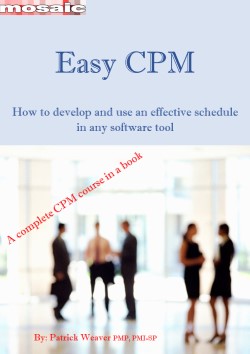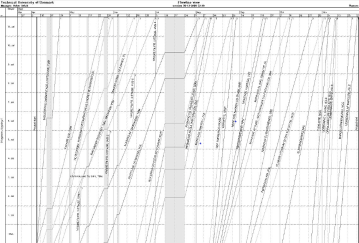Location:
PMKI > Project
Controls and Scheduling > Scheduling
Methodologies & Approaches.


- Scheduling concepts and theories
- Earned Duration
- Scheduling methodologies and
approaches
- Line of Balance ( LOB
)
- Useful External Web-links &
Resources.
Other related sections of the PMKI:
- CPM Schedule Management -
Overview
- Schedule Development &
Time Analysis
Note: Agile is treated as a product development
methodology, and project management approach:
See more on Agile.
 5-STEPS
the ‘5 Steps To Ensure Project Success’ methodology is a
proven process designed to focus the thinking of key
Stakeholders onto the parameters required to achieve a
successful project outcome.
5-STEPS
the ‘5 Steps To Ensure Project Success’ methodology is a
proven process designed to focus the thinking of key
Stakeholders onto the parameters required to achieve a
successful project outcome.
5-STEPS uses the development of the schedule as a central
plank in its approach to developing an effective project
team and fostering positive stakeholder involvement. Download the paper.
The ‘5 Steps To Ensure Project Success’ process is designed as a logical sequence of activities (and importantly, agreements) but recognizes iterative passes through some of the key steps may be required to achieve agreement. The five sequential steps are:
The 5–STEPS methodology requires each step to be completed, validated and "signed off" before moving onto the next. This approach is incorporated in Easy CPM with a range of additional hits and tips to get the best out of your current scheduling tools.
 Easy CPM is
a course-in-a-book that provides practical training and
guidance to individuals and organizations involved in
developing or using CPM schedules based on the Critical
Path Method (CPM). It is designed to act as both a
reference, and practice guide, for people implementing CPM
scheduling after they have learned to use the CPM
scheduling software of their choice.
Easy CPM is
a course-in-a-book that provides practical training and
guidance to individuals and organizations involved in
developing or using CPM schedules based on the Critical
Path Method (CPM). It is designed to act as both a
reference, and practice guide, for people implementing CPM
scheduling after they have learned to use the CPM
scheduling software of their choice.
Advanced Work Packaging (AWP). Uses long-accepted estimating, scheduling and 3D modeling techniques, AWP pivots a project’s planning philosophy into planning backwards from a defined end goal, focusing on when preceding work is needed in order to increase the likelihood of on-time completion. It combines elements of Critical Chain, WBS, and EVM. AWP is equally relevant to both owner and contractor organizations, driving a more collaborative and transparent approach to executing projects. A detailed explanation of AWP is contained in Advanced Work Packaging, by Ineight - Download the paper.
Beeline Diagramming Method (BDM). Beeline represents the overlapping relationship between two consecutive tasks by the shortest straight line (the beeline). BDM connects any point in the predecessor to any point in the successor. Download the paper.
The Chronographic Diagramming Method. The Chronographic Model uses the concept of internal divisions and internal measurement as a function of production and converts relationships into internal divisions and internal relationships related to a quantity of workload, thus delaying or anticipating the start of the second activity in order to respect the predecessor production. Download the paper.
Count the Squares (CTS). CTS was used In the 1970s to assess overall progress on a schedule developed as a bar chart (Gantt chart), or the bar chart representation of a CPM schedule. In CTS each day of an activities duration was counted as ‘1’ and the cumulative planned days for the whole schedule is compared to the cumulative days work actually accomplished. This simlpe approach has been superseded by Earned Duration.
Earned Duration (ED), or, Earned Duration Management (EDM). EDM is a methodology that creates duration-based performance metrics and aims to decouple schedule and cost performance measures. It is a method of assessing schedule performance based on the comparing the duration of activities 'as-planned' and 'as-accomplished'. ED modifies the basic CTS process, outlined above, by adjusting the 'earned duration' for each activity based on the current expected duration. The fundamental weakness in this approach is its assumption that one days work on one activity in a bar chart is equivalent to any other day's work on any other activity, where in reality the the resources assigned to one activity in a schedule may be 1 person per day and another 15 people per day. This is the opposite of the earned value approach that assumes the amount of effort required to complete each $thousand of budget/value is the same regardless of the type of work (and cost of materials) covered by the budget - see more on earned value management. Studies have found ED and ES both produce reliable results, with ES marginally more consistent. Download Stochastic Earned Duration Analysis for Project Schedule Management.
Earned Schedule (ES) is an extension to traditional Earned Value Management (EVM) that uses EVM data to provide a reliable prediction of a project's expected completion date. ES overcomes the limitations in ED/CTS by using the value of the work accomplished as a reasonable proxy for the resources being used to accomplish the work. See more on Earned Schedule (ES).
Momentology focuses on measuring the momentum of work on the project. Each section of a project has its momentum as does the overall project. The loss of momentum is a reliable predictor of a delayed completion. See WP1036 Momentology.
Rolling Wave Planning is the process of progressively increasing the detail in a schedule as more information becomes available. Work in the near term is planned in detail, later work is left as higher-level planning components. Detail may be added in layers; initially as planning packages (reflected in the schedule as a single activity), then as a number of work packages (each reflected in the schedule as a single activity), then as detailed activities. The key requirement is that the schedule is fully detailed before work starts on that portion of the project. See WP1060 Rolling Wave Planning.
Schedule Density, is similar to rolling wave
planning but designed for modern software. Initially
the overall project is planned at Low Density; work
planned to occur within the next year or so is scheduled
at Medium Density, and work planned to occur in the next 3
months is scheduled at High Density and defines in detail
who will be doing what, where and when (normal schedule
activities).
See WP1016 Schedule Density.
Timeboxing, is a simple process used to measure the completion of a defined amount of work in a fixed period, plus or minus an allowed variation (the 'time box'). Commonly used in Scrum and other Agile methodologies to define sprints or iterations. See WP1020 Timeboxing.
Work Performance Management, a practical option to assess the current status, and expected completion date of projects that are not using CPM or EVM. Click through to see more.
 Barcharts
or Gantt Charts are a simple graphical
representation of the project schedule. The concept was
originally developed by Joseph Priestley in 1765. This
type of chart lists the tasks to be performed on the
vertical axis, and time intervals on the horizontal axis.
The the horizontal length of the bars in the graph shows
the duration of each activity. Barcharts may be either a
static drawing or a presentation of a dynamic schedule. See our list of
barcharting tools.
Barcharts
or Gantt Charts are a simple graphical
representation of the project schedule. The concept was
originally developed by Joseph Priestley in 1765. This
type of chart lists the tasks to be performed on the
vertical axis, and time intervals on the horizontal axis.
The the horizontal length of the bars in the graph shows
the duration of each activity. Barcharts may be either a
static drawing or a presentation of a dynamic schedule. See our list of
barcharting tools.
Critical Chain is a method of planning and
managing projects that puts the main emphasis on the
resources required to execute project tasks. Work is
scheduled to occur when needed, using an optimistic
duration estimate. Overall completion is protected by the
use of time buffers.
See WP1050 Critical Chain.
Critical path method. The critical path method (CPM), or critical path analysis (CPA), is an algorithm for scheduling a set of project activities to determine when each activity can start and finish. The critical path is determined by identifying the longest series of dependent activities controlling a completion date, and measuring the time required to complete them. See our list of CPM tools.
Last Planner System (LPS), is based on a collaborative approach to managing a project and is usually associated with Lean Construction. The essentials for using LPS include involving the entire team, following milestones, setting a schedule, setting durations, having weekly plans, setting daily morning meetings, having weekly meetings, and updating the plan and schedule as needed. Despite the hype, the idaea are far from new, see The Last Planner and other Old Ideas
Line of
Balance (LOB) is a method of showing the repetitive
work that may exist in a project as a single line on a
graph and compares the rate at which the work has to be
undertaken to stay on schedule with the actual rate of
production. See
WP1021 Line of Balance.
This approach was used in the 1930s to manage the
construction of the Empire State Building in New York and
has been expanded to encompass a range of similar
techniques including:
 -
Chainage Charts / Time Chainage Diagram
-
Chainage Charts / Time Chainage Diagram
- Flow Line
- Line of Balance (LOB)
- Linear Schedule (LS) - see AACEi in
links below)
- Linear Scheduling Method (LSM)
- Location based scheduling (LBS)
- March Chart
- Time-location charts, and
- Vertical Production Method (VPM)
In most cases all that really changes is the name.
See some of the available
LOB software tools.
LOB is typically used on projects where the majority of
the scope is made up of highly repetitive work elements
along a horizontal or vertical alignment such as pipeline,
tunnel, airport runway, highway, transmission line, road
resurfacing, railroad, or high-rise construction projects.
Multiple Activity Charts (or Multi-Activity Charts) are a very useful tool for understanding the flow of work in a cyclical process and as a consequence understanding which resource is controlling the overall progress. See WP1025 Multiple Activity Charts.
Pull Planning Using a deliverable breakdown structure, this approach focuses on right-to-left, or ‘end-first’ planning, which involves starting from the project’s deliverables and working in reverse order to identify the necessary steps to achieve them. Pull planning works as a scheduling tool for the Last Planner System (LPS), which is based on a collaborative approach to managing a project.
RD CPM™, The Relationship Diagramming variation of the Critical Path Method of schedule analysis developed by Fredric L. Plotnick. Numerous scheduling tools are certified as incorporating RD-CPM. See WP1035 Relationship Driven CPM.
The RD-CPM website: http://www.fplotnick.com/RDCPM.htm
AACEi Recommended Practice 129R-23: Linear Scheduling Methods: main objectives of this recommended practice (RP) are to increase LSM usage and enhance project management practices by delineating the steps and main considerations in developing, updating, managing, and using linear schedules.